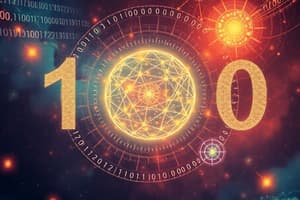Podcast
Questions and Answers
What does the term 'digital' refer to?
What does the term 'digital' refer to?
A process that is achieved by using discrete units.
What is the radix or base of a number system?
What is the radix or base of a number system?
The number of different digits which can occur in each position in the number system.
What divides the integer and fractional parts in a positional number system?
What divides the integer and fractional parts in a positional number system?
Radix point.
How can a number in a base 'r' be generally written?
How can a number in a base 'r' be generally written?
Which of the following are types of number systems? (Select all that apply)
Which of the following are types of number systems? (Select all that apply)
How many unique symbols does the decimal number system contain?
How many unique symbols does the decimal number system contain?
What symbols are used in the binary number system?
What symbols are used in the binary number system?
What is the base or radix of the octal number system?
What is the base or radix of the octal number system?
What symbols does the hexadecimal number system use?
What symbols does the hexadecimal number system use?
What is the result of converting (10101)2 to decimal?
What is the result of converting (10101)2 to decimal?
What is the result of converting (111.101)2 to decimal?
What is the result of converting (111.101)2 to decimal?
In a binary to octal conversion, how are binary numbers grouped?
In a binary to octal conversion, how are binary numbers grouped?
What is the octal equivalent of the binary number (101111010110.110110011)?
What is the octal equivalent of the binary number (101111010110.110110011)?
Flashcards are hidden until you start studying
Study Notes
Number Systems
- Digital processes use discrete units, each with an absolute and place value.
- Radix/Base determines the number of unique digits within a number system, and the value of each digit depends on its position.
- The Radix Point, similar to a decimal point, separates the integer and fractional portions of a number.
Types of Number Systems
- Decimal System uses ten digits (0-9) with a radix of 10. The value of a digit is calculated by multiplying it with the corresponding power of 10.
- Binary System is a base-2 system, using only 0 and 1. Each digit is multiplied by its corresponding power of 2. A binary digit is known as a bit.
- Octal System has a base of 8, using digits 0-7. It's related to binary, where every 3-bit group can be represented by an octal digit.
- Hexadecimal System is base-16, using digits 0-9 and letters A-F to represent values 10-15. Every 4-bit group of binary can be represented by a hexadecimal digit.
Conversions
- Binary to Decimal: Multiply each binary digit with its power of 2 and sum the results.
- Binary to Octal: Group binary digits into sets of three (starting from the binary point), convert each set to an octal digit.
- Binary to Hexadecimal: Group binary digits into sets of four, convert each set to a hexadecimal digit.
Studying That Suits You
Use AI to generate personalized quizzes and flashcards to suit your learning preferences.



